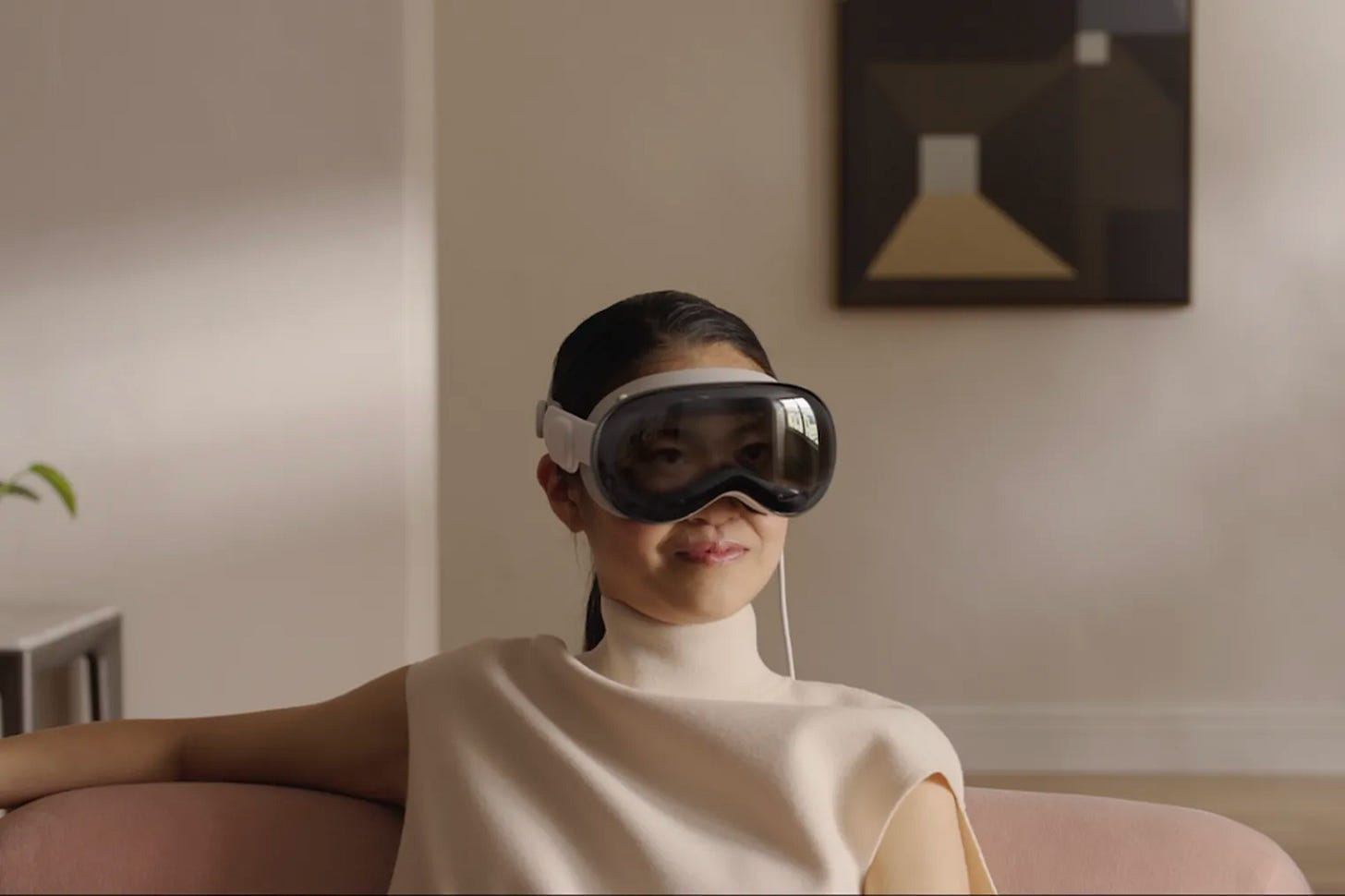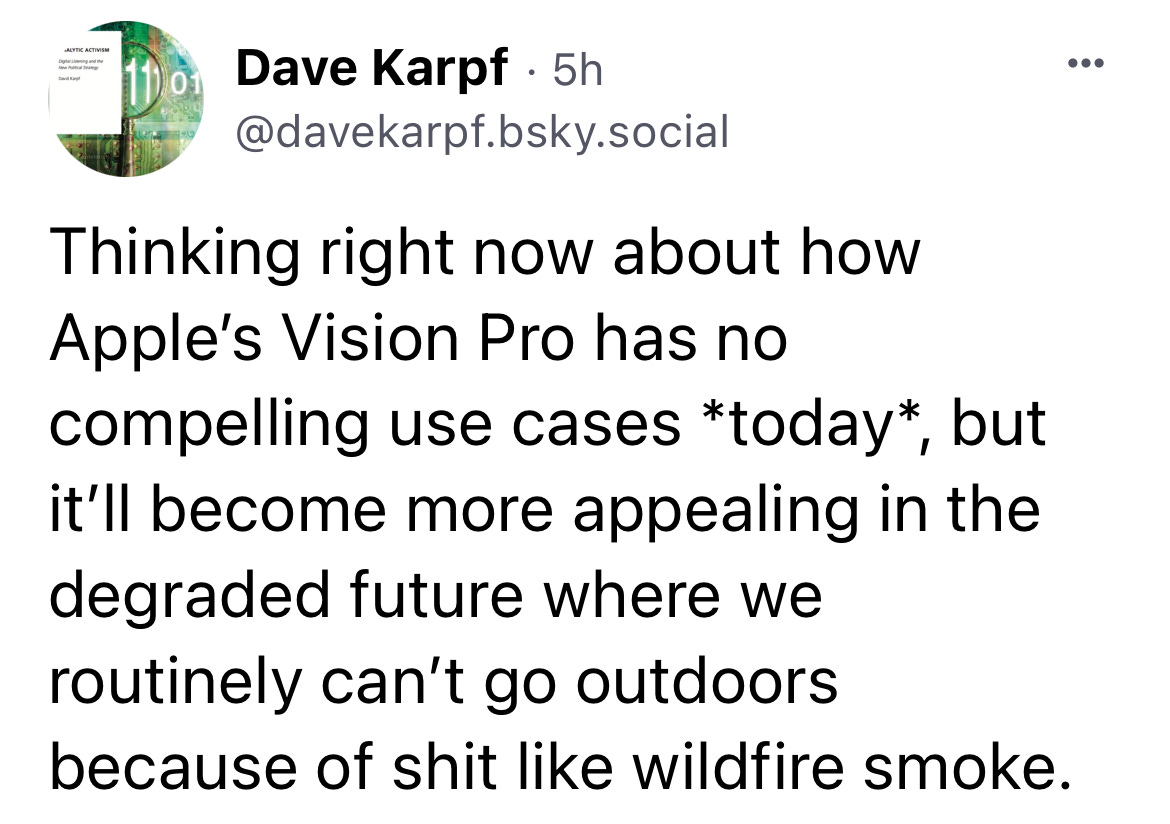On Jackpot Technologies, or, what Apple's new headset is actually *for*
The future is going to be worse than the present. Strap in, tune out.
This ought to be a victory-lap post. An I-told-you-so post. A let’s-cackle-at-these-rich-fools post. Those are such fun posts to write.
We’ve been told for years that it was too soon to pass judgment on the current crop of VR/AR/MR headsets. Wait for Apple. Apple is building something incredible. Apple’s headset will be the mass market game changer.
Now Apple has revealed its headset, and all the reviews fixate on the same points: it’s a technical marvel. It’s absurdly expensive. But let’s give it a few years, until the prices come down and the market develops. Then we’ll see…
I wrote a piece for WIRED back in 2021 where I called Virtual Reality (along with Augmented Reality and Mixed Reality) headsets the “Rich White Kid of Technology” — always judged based on their imagined potential, rather than their actual performance. I argued that these technologies all suffer from a demand-side problem that I call the “Field of Dreams fallacy” (If you build it, they will come). The reason why these headsets keep failing to live up to investor expectations is that most people don’t actually want to live in Virtual Reality or Augmented Reality.
The piece has some good zingers in it. I think it holds up well. But, more and more, I’ve become convinced that there is a substantial role for these headsets. Not right away! In the near-term, I expect Apple’s Vision Pro will be a flop. There simply isn’t much you can DO with the device, and at $3,500 I doubt many people will buy it on a lark just to fiddle with it.
But in the longer term, I think “spatial computing”/computers-on-your-face will have a real niche. And the technical breakthroughs in the Vision Pro could matter a lot in the years to come. This could one day be remembered as a turning point.
In his product review, Nilay Patel writes:
Apple has clearly solved a bunch of big hardware interaction problems with VR headsets, mostly by out-engineering and out-spending everyone else that’s tried. But it has emphatically not really answered the question of what these things are really for yet[…]
Apple’s headset isn’t for anything right now. It’s, to borrow a phrase from William Gibson’s The Peripheral, a Jackpot Technology. It becomes increasingly compelling in a degraded future where much of what we take for granted in the present becomes less accessible.
I walked to and from the Metro yesterday. I had jury duty, and there is a subway stop right by the courthouse. Five blocks, wearing a mask. I’ve never been diagnosed with asthma. I don’t own an inhaler. But I’ve had occasional allergy-induced respiratory trouble. I’m risk category-adjacent. The walk was harder on my lungs than when I got COVID earlier this year. I had trouble climbing the stairs last night. My daughter was so concerned she told me to borrow one of her stuffies until my lungs got better.
This is all because of Canadian wildfires and some unfortunate wind patterns. People on the west coast deal with this every year. My parents in Oregon have become accustomed to checking the air quality to see if they can go outside that day.
We’re on course for a future where this is commonplace. There will be more wildfires. There will still be wind patterns. Some weeks, you just won’t be able to go outside.
Under those circumstances, the headset sounds a lot more appealing. Yes, please, sign me up for the spatial overlay where I can work/and or relax in relative privacy. Brian Merchant describes the Vision Pro as “the anti-metaverse,” a new way to be alone. It isn’t better than the status quo we have available today, but it is preferable to the alternatives we’ll face tomorrow.
That’s the discomforting undercurrent of these technological innovations. This isn’t the World’s Fair. This isn’t olde timey EPCOT futurism. The future we are headed towards will, in so many ways, be worse than the present. Apple’s Vision Pro is a prototype of the sort of luxury commodity that will become more attractive in degraded tomorrowland. It holds the promise that those-who-can-afford-it will be able to shut out everyone and everything that lies outside their immediate field of vision. Just tweak the Operating System a little and you could one day limit intrusions to those with permission to be there. (Apple Vision Pro: Welcome to the Gated Community of the Mind!)
Here’s another use-case that particularly weighs on me right now (and granted, this one may be harder for most readers to relate to):
I spent the past couple weeks traveling for work. First I flew to a conference of critical AI researchers in Montreal. Then I took a train to Toronto for the International Communication Association (ICA) Annual Meeting. (There was a third international event after that, but it’s a subject for a future post.)
On paper, these conferences can seem like a waste. I gave a 15-minute presentation in Montreal to about 30 people. I gave a 12-minute presentation in Toronto to about a dozen people. That’s a long way to travel for such short research presentations.
But the value of the conference isn’t in the paper presentation. It’s in the copresence. I spent a solid week talking with disciplinary peers. We gave each other feedback on projects, hatched new ideas, gossiped and argued a bit. I met grad students who are just getting started in the field. I caught up with old friends and mentors. I got a sense of where the research community is heading, which helps shape where I want my own research to head next.
These were both hybrid conferences. One could attend in-person or over zoom. I’m glad that they are zoom-accessible, but the zoom-conference experience is a second-class experience and I think everyone knows it. Zoom-copresence isn’t real copresence. There’s no hallway chatter. No “hey do you have lunch plans.” No “what are you working on these days?” No “it’s so great to meet you!”
(That being said, a ton of in-person attendees got COVID after the conference. Zoom-copresence doesn’t give you COVID.)
Next year, I won’t be attending these conferences in-person. My university has a budget crunch, so they’ve zeroed out scholarly travel for all tenured faculty. Unless I snag a big research grant to support my read-all-the-WIRED-magazines efforts, all my conferences in the foreseeable future will be zoom-conferences.
It’s an awkward thing to complain about (oh poor me… won’t someone please think about the travel budgets for tenured faculty?!?). But I suspect its also a harbinger. In-person academic conferences are good. They’re nice. They’re much better than the existing alternative. And they’re also, most likely, unsustainable. We are not on a trajectory towards having more public funding available for social science research, or for higher education in general. Many of the things we take for granted in the present will be luxury goods in the future.
Which brings me back to the Vision Pro. Spatial computing will never be as nice as the actual, in-person event. We ask “what is this for?” because, today, it isn’t for much of anything. We naturally compare this technological imaginary to the status quo. But what if the status quo is does not last?
The two biggest conferences in my field are the ICA annual meeting and the American Political Science Association Annual Meeting. The registration fee is $500 for each. Flights cost between $200 and $500, depending on location. Hotels are maybe $200 per night. So, back-of-the-envelope, attending both conferences in a single year costs around $3,500. (Which, to be clear, is already a lot more than our standard scholarly travel budget.)
$3,500 is a lot of money for a face-computer to play with around the house. But if they meaningfully improve on zoom-copresence, and if I’m going to be confined to zoom-conferences from here on out? Maybe in a few years I can get GW to buy me a Vision Pro in lieu of replacing my desktop workstation.
Paris Marx argues that Apple’s headset should be ridiculed. I often agree with Paris, and making fun of these big, splashy attempts by giant tech companies to build the future is certainly my idea of a good time.
I’m having trouble finding any mirth in it, though. When I look at Apple’s Vision Pro, I see a luxury device for a degraded future. But I also can’t go outside and breath the air right now.
I would prefer to log off and touch grass than immerse myself in the Vision Pro’s smooth architecture of semi-privacy. I’d rather grab meals and coffees with my peers and give short research presentations in small conference rooms than interact with people through a face-computer.
But we’re on track for a world where, some weeks, there will be wildfires in Canada and you just can’t go touch grass in Washington, DC. And I suspect that’s a world where those who can afford it will find a headset like the Vision Pro very appealing.
It’s a Jackpot technology. It isn’t for anything in today’s world. It’s purpose-built for a diminished future.






This sentence:
"It isn’t better than the status quo we have available today, but it is preferable to the alternatives we’ll face tomorrow."
reminds me of a Russian joke an old neighbour of mine told me:
An old man, asked how his family was doing, said "On average, we live pretty well. Not as good as last year, but not as bad as next year will be."
Apologies from the province of Quebec for the wildfire smoke!
Boy oh boy. "What if the status quo isn't sustainable" is The unasked question because everyone is (or should be) terrified of the answer. The billionaires have their New Zealand compounds as their answer, which should make anybody who still see them as visionaries really, really nervous. It's something everybody knows, but swallowing the implications is more than most of us can handle. Maybe this is what's at the root of all the free-floating unfocused insecurity in developed nations' populations with their long national nightmare of Peace and Prosperity. The centuries of wealth and growth from exploiting natural resources and ingoring/socializing the costs Party is winding down, and the waiter is standing there with the bill. Simple psychotic-break level denial is the easiest answer, so it should be no surprise that it's the American default. It's worked before. The dust bowl went away, and who needs passenger pigeons anyway? We'll Tech our way around it! It's always worked before.